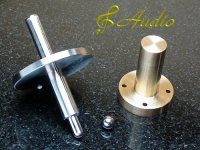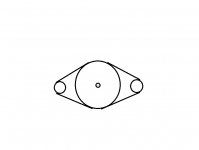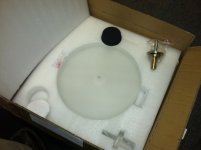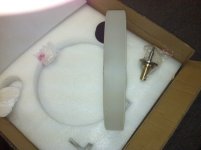this may be a redundant topic here but i think that starting a new thread may be easier than searching through them all...basically platter and bearing is custom from choir audio and ways in about 30lbs and want to drive it on the perimeter via a separate motor housing and control with a belt...a few options out there I have looked at like origin live dc but seem pricey for what it is...ebay stuff like ffyx ac motor and drive is cheaper stuff but questionable quality...I have checked out premotec and maxon websites but wich one??...then a control unit to go with? I realize this is a loaded topic when it comes to building tt's but I am in no hurry to get it done...I just want advice on purchasing a suitable motor and a circuit and I will design the rest of the housing parts and have them made elsewhere...advice from anyone out there who thinks they know best would me much appreciated 
Search for the Mark Kelly motor controller.this may be a redundant topic here but i think that starting a new thread may be easier than searching through them all...basically platter and bearing is custom from choir audio and ways in about 30lbs and want to drive it on the perimeter via a separate motor housing and control with a belt...a few options out there I have looked at like origin live dc but seem pricey for what it is...ebay stuff like ffyx ac motor and drive is cheaper stuff but questionable quality...I have checked out premotec and maxon websites but wich one??...then a control unit to go with? I realize this is a loaded topic when it comes to building tt's but I am in no hurry to get it done...I just want advice on purchasing a suitable motor and a circuit and I will design the rest of the housing parts and have them made elsewhere...advice from anyone out there who thinks they know best would me much appreciated
You might buy a PCB here: DIY Projects by Sylvain Bergeron and ask for the schematic and instructions too.
You'll have a hard time find something better for DIY.
If you don't mind me asking, what was the price for the platter. I have been searching for a platter for nearly a year now, to make my own. But have just about given up.
Was about 1200 Canadian but that included the bearing assembly...there is photos of that particular design that I did with Choir on his DIY web-sight...they also have a basic one inch for about half that price that includes bearing assembly...mine is the polished 2.5" witch I designed with autocad and then had Choir Audio manufacture
Choir Audio
yes I realize that Choir will also custom build a TT drive but like I said I am not in any hurry and I would like to put as much of my own design as possible into this project
Ah...one of the cruxes of DIY turntables...
I've looked at this for quite a while now, and have even designed a complete turntable suitable as a belt, rim or idler drive. The motor system could be either AC or DC.
There are pluses and minuses to everything, but each type of motor system can have their own issues. I agree that the Mark Kelly/Sylvain Bergeron DC controller PCB makes a lot of sense if DC is what you are after. I think there is the ability to compensate for increased temperature and load. I'll have to re-read the documentation.
For AC synchronous speed controls the issue is getting to the correct frequency to drive the motor at the correct speed. This entails the use of high precision oscillator (thankfully readily available), some sort of filter to keep noise to a minimum, and the inclusion of an amplifier circuit to get to an appropriate voltage AND/OR the use of a phasing capacitor . If using only a phasing capacitor you rely on the AC mains frequency (and hope the frequency of your mains is dead on 50Hz or 60Hz, whatever the case may be). So initially the AC motor/capacitor system can get you started.
The phasing capacitors for a particular speed to be maintained are motor specific (well more correctly the number of poles) and are usually provided by the motor manufacturers. Also you must determine the AC voltage you want to run at. For example Hurst (and I am not neccessarily recommending them) has a 24VAC and a 115 VAC motor that is essentially identical, but require different phasing capacitor. AFAIK dropping the voltage increases torque so there is some appeal to that option. But a much larger capacitor (or group of capacitors) is required and are not included with the 24 VAC version motor.
Regardless of which motor type and what the designed RPM for the motor is, drive pulleys are required (or spindle extensions, etc) and some means of either altering the frequency (for AC drives) and/or the voltage required (mainly for DC types, but altering the voltage for AC motors can get you to a "sweet spot" where mechanical noise is reduced to a minimum, while still maintaining the ability to drive the platter as per the requirements for a Premotec motor as used in the Linn LP12.
This is not meant to create an new thread, there are enough here and various other sites that discuss/argue the merits of AC vs DC motors and their use in turntables.
Hope this helps and doesn't add to the confusion ...
...
I've looked at this for quite a while now, and have even designed a complete turntable suitable as a belt, rim or idler drive. The motor system could be either AC or DC.
There are pluses and minuses to everything, but each type of motor system can have their own issues. I agree that the Mark Kelly/Sylvain Bergeron DC controller PCB makes a lot of sense if DC is what you are after. I think there is the ability to compensate for increased temperature and load. I'll have to re-read the documentation.
For AC synchronous speed controls the issue is getting to the correct frequency to drive the motor at the correct speed. This entails the use of high precision oscillator (thankfully readily available), some sort of filter to keep noise to a minimum, and the inclusion of an amplifier circuit to get to an appropriate voltage AND/OR the use of a phasing capacitor . If using only a phasing capacitor you rely on the AC mains frequency (and hope the frequency of your mains is dead on 50Hz or 60Hz, whatever the case may be). So initially the AC motor/capacitor system can get you started.
The phasing capacitors for a particular speed to be maintained are motor specific (well more correctly the number of poles) and are usually provided by the motor manufacturers. Also you must determine the AC voltage you want to run at. For example Hurst (and I am not neccessarily recommending them) has a 24VAC and a 115 VAC motor that is essentially identical, but require different phasing capacitor. AFAIK dropping the voltage increases torque so there is some appeal to that option. But a much larger capacitor (or group of capacitors) is required and are not included with the 24 VAC version motor.
Regardless of which motor type and what the designed RPM for the motor is, drive pulleys are required (or spindle extensions, etc) and some means of either altering the frequency (for AC drives) and/or the voltage required (mainly for DC types, but altering the voltage for AC motors can get you to a "sweet spot" where mechanical noise is reduced to a minimum, while still maintaining the ability to drive the platter as per the requirements for a Premotec motor as used in the Linn LP12.
This is not meant to create an new thread, there are enough here and various other sites that discuss/argue the merits of AC vs DC motors and their use in turntables.
Hope this helps and doesn't add to the confusion
Nanook...thanx for ur input... old school quartz locked direct dc drives back in the day of cheap jap tables was considered premium by sum...ac belt drives were cheaper still...the technology and engineering of a direct drive allowed some degree of speed control with a relatively inexpensive circuit...today it seems to be a different trend...to change the speed of ac synchronous means expensive variable frequency drive (VFD) or pulley machined to exact spec with platter and country ac frequency...dc might seem simpler and cheaper that will work world wide and may vibrate less?...but the speed is not locked in like a synchronous witch has clock like accuracy...but ac motor emits low frequency noise...ac synchronous may be the way to go if speed control is not that important to the individual...get the pulley right and simple supply circuit and its done...just isolate motor from platter without losing speed consistency from belt pulley slip and belt stretch...to much isolation may be a bad thing as well when it comes to motor and platter interaction...direct is better in that regard...stylus drag and low frequency feed back will cause motors that are mounted on compliant suspension and drive with a rubber belt to oscillate out of sync with platter...even the best set ups will have a series of compromises...my rant for the day
Hey there, I thought id give a little tidbit. I'm not sure if you've considered a dc motor running through a square wave controller. I'm not sure if anyone sells them, but there are kits that with some programming can be made to run them. if your platter is very heavy as you say it is, the square wave frequency high, and the belt elastic, and the motor mount non compliant, the speed control should be very smooth, and actively counters wear of changes in setup. also the speed with be infinity variable, not very practical, but handy for some of the strange sizes.
This kit :
USB Interface Experiment Board Electronic Kit K8055
can be pretty handy in general and is what I've used. it's pretty sweet.
Just putting it out there.
Cheers
This kit :
USB Interface Experiment Board Electronic Kit K8055
can be pretty handy in general and is what I've used. it's pretty sweet.
Just putting it out there.
Cheers
AFAIK dropping the voltage increases torque so there is some appeal to that option.
No.
As an example, all Hurst model A low torque motors (models 3001 - 00X) have 14mNm at 300 RPM regardless of rated voltage. The high torque motors (models 3009 - 00X) have 19mNm but are to be avoided due to excessive cogging torque.
Don't forget that the available torque is multiplied by the gearing ratio of the drive so torque at the platter is 9 X the figure given.
I got a quote from Choir Audio for a 2" platter polished and their bearing for $1300.
If you can use acrylic, 8audio.com has a platter for just over $200 with $80 shipping.
I bought an attenuator from them and the quality was good. Haven't purchased a platter, but strongely considering it.
BTW- the Choir Audio DIY parts are no more. They only make custom platters or you can buy their table.
If you can use acrylic, 8audio.com has a platter for just over $200 with $80 shipping.
I bought an attenuator from them and the quality was good. Haven't purchased a platter, but strongely considering it.
BTW- the Choir Audio DIY parts are no more. They only make custom platters or you can buy their table.
Last edited:
I didn't think the bearing housing and spindle were anywhere near long enough to offer decent sideways support
I'm trying to understand what you mean by "sideways support", and I can only assume you mean the way the belt pulls around the side of the platter toward the motor. If the bearing is a slip fit, how could it be a problem?
I was going to either have two motors (not likely) or use something like a "fly wheel" so the belt touches both side equally when rotating the platter.
See attachment. Not drawn to scale.
In either case, a new bearing is easier to turn on a lathe than a platter.
Attachments
The platter arrived in the mail today. Well packed. Looks very nice.
I am told the platter is concentric to 1/1000th. The bearing is bigger and heavier than I thought it would be.
I picked up their 700g record weight. Also very nice.
Now for the hard part...
I am told the platter is concentric to 1/1000th. The bearing is bigger and heavier than I thought it would be.
I picked up their 700g record weight. Also very nice.
Now for the hard part...
Attachments
most of the plater is above the centre point of the bearing
I noticed that, but it's fine for what it is. The bearing plate goes in about 1/8 the depth of the platter. I would have liked to seen it go 1/2 way, like the Choir platter. That platter is $1000 more. For that money, I would just buy a VPI Traveler. This is fine for a DIY build.
Once spinning, it just keeps going. It's not warps and I'm happy about that fact.
You know, this had me thinking (dangerous, I know!) about the issue of side loading etc. A top heavy platter above the center point could create more side pressure on the bearing but this may be less of an issue when the turntable is running. Think of a spinning top or a gyroscope, when they spin they stay in a more balanced vertical stance. May be somewhat the same with a turntable platter in motion.
Now I know that gyros and tops spin at much higher speed than a turntable platter, but perhaps the forces at play are still an influence with slower turning tt platter speeds but relatively high mass of the platter.
Normally we would want reduced side pressures during play to reduce vibration and rumble. If this is the case, then what would be important is that the spindle and platter assembly are perfectly concentric and balanced.
Hmmm, just a thought.
Now I know that gyros and tops spin at much higher speed than a turntable platter, but perhaps the forces at play are still an influence with slower turning tt platter speeds but relatively high mass of the platter.
Normally we would want reduced side pressures during play to reduce vibration and rumble. If this is the case, then what would be important is that the spindle and platter assembly are perfectly concentric and balanced.
Hmmm, just a thought.
Any spinning object subjected to a force which attempts to tip the axis of spin (eg a torque applied orthogonally to the axis of spin) reacts to that force by precessing. Precession casues the contact point of the spindle in the bearing to revolve constantly.
The frequency and the force of the precession are easily calculable if you know the velocity and inertia of the spinning object and the deflection torque. In the case of TT platters it's a very slow but very powerful force.
The frequency and the force of the precession are easily calculable if you know the velocity and inertia of the spinning object and the deflection torque. In the case of TT platters it's a very slow but very powerful force.
- Status
- This old topic is closed. If you want to reopen this topic, contact a moderator using the "Report Post" button.
- Home
- Source & Line
- Analogue Source
- motor and circuit for diy turntable project



